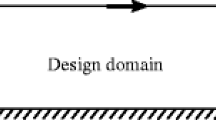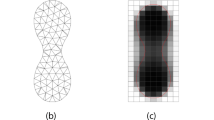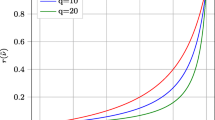Abstract
Variable thickness sheet and homogenization-based topology optimization often result in spread-out, non-well-defined solutions that are difficult to interpret or de-homogenize to sensible final designs. By extensive numerical investigations, we demonstrate that such solutions are due to non-uniqueness of solutions or at least very flat minima. Much clearer and better-defined solutions may be obtained by adding a measure of non-void space to the objective function with little if any increase in structural compliance. We discuss various alternatives for cleaning up solutions and propose two efficient approaches which both introduce an auxiliary field to control non-void space: one approach based on a cut element based auxiliary field (hybrid approach) and another approach based on an auxiliary element based field (density approach). At the end, we demonstrate significant qualitative and quantitative improvements in variable thickness sheet and de-homogenization designs resulting from the proposed cleaning schemes.




















Similar content being viewed by others
Notes
The lower bound 0.001 and not 0 is used here since MMA usually does not reach 0 due to rounding issues.
The hole introduction strategy was not allowed to introduce holes at loaded boundaries.
References
Allaire G, Francfort GA (1993) A numerical algorithm for topology and shape optimization. In: Bendsøe MP, Mota Soares CA (eds) Topology optimization of structures. Kluwer Academic Publishers, pp 239–248
Allaire G, Kohn RV (1993) Explicit bounds on the elastic energy of a two-phase composite in two space dimensions. Q Appl Math 51:675–699
Allaire G, Geoffroy-Donders P, Pantz O (2019) Topology optimization of modulated and oriented periodic microstructures by the homogenization method. Comput Math Appl 78(7):2197– 2229
Andreassen E, Clausen A, Schevenels M, Lazarov B, Sigmund O (2011) Efficient topology optimization in MATLAB using 88 lines of code. Struct Multidiscip Optim 43:1–16. https://doi.org/10.1007/s00158-010-0594-7. MATLAB code available online at: www.topopt.dtu.dk
Andreasen CS, Elingaard MO, Aage N (2020) Level set topology and shape optimization by density methods using cut elements with length scale control. Struct Multidiscip Optim 62(2):685–707. https://doi.org/10.1007/s00158-020-02527-1
Belytschko T, Parimi C, Moës N, Sukumar N, Usui S (2003) Structured extended finite element methods for solids defined by implicit surfaces. Int J Numer Methods Eng 56(4):609–635. https://doi.org/10.1002/nme.686
Borrvall T, Petersson J (2001) Topology optimization using regularized intermediate density control. Comput Methods Appl Mech Eng 190:4911–4928
Bourdin B (2001) Filters in topology optimization. Int J Numer Methods Eng 50(9):2143–2158. https://doi.org/10.1002/nme.116
Burman E, Claus S, Hansbo P, Larson MG, Massing A (2015) CutFEM: discretizing geometry and partial differential equations. Int J Numer Methods Eng 104(7):472–501. https://doi.org/10.1002/nme.4823
Daux C, Moës N, Dolbow J, Sukumar N, Belytschko T (2000) Arbitrary branched and intersecting cracks with the extended finite element method. Int J Numer Methods Eng 48(12):1741–1760. https://doi.org/10.1002/1097-0207(20000830
Düster A, Parvizian J, Yang Z, Rank E (2008) The finite cell method for three-dimensional problems of solid mechanics. Comput Methods Appl Mech Eng 197(45–48):3768–3782. https://doi.org/10.1016/j.cma.2008.02.036
Eschenauer HA, Kobelev VV, Schumacher A (1994) Bubble method for topology and shape optimization of structures. Struct Optim 8(1):42–51. https://doi.org/10.1007/BF01742933
Evgrafov A, Sigmund O (2020) Sparse basis pursuit for compliance minimization in the vanishing volume ratio limit. ZAMM - J Appl Math Mech 100(9):e202000008. https://doi.org/10.1002/zamm.202000008
Geoffroy-Donders P, Allaire G, Michailidis G, Pantz O (2020a) Coupled optimization of macroscopic structures and lattice infill. Int J Numer Methods Eng n/a(n/a). https://doi.org/10.1002/nme.6392
Geoffroy-Donders P, Allaire G, Pantz O (2020b) 3-d topology optimization of modulated and oriented periodic microstructures by the homogenization method. J Comput Phys 401:108994. https://doi.org/10.1016/j.jcp.2019.108994
Groen J, Sigmund O (2018) Homogenization-based topology optimization for high-resolution manufacturable microstructures. Int J Numer Methods Eng 113(8):1148–1163. https://doi.org/10.1002/nme.5575 (online since April 2017)
Groen JP, Wu J, Sigmund O (2019) Homogenization-based stiffness optimization and projection of 2d coated structures with orthotropic infill. Comput Methods Appl Mech Eng 349:722–742. https://doi.org/10.1016/j.cma.2019.02.031
Groen JP, Stutz FC, Aage N, Bærentzen JA, Sigmund O (2020) De-homogenization of optimal multi-scale 3d topologies. Comput Methods Appl Mech Eng 364:112979. https://doi.org/10.1016/j.cma.2020.112979
Groen J, Thomsen C, Sigmund O (2021) Multi-scale topology optimization and de-homogenization using implicit geometry modeling. Struct Multidisicip Optim, Online
Hansbo A, Hansbo P (2002) An unfitted finite element method, based on Nitsche’s method, for elliptic interface problems. Comput Methods Appl Mech Eng 191(47–48):5537–5552. https://doi.org/10.1016/S0045-7825(02)00524-8
Larsen S, Sigmund O, Groen J (2018) Optimal truss and frame design from projected homogenization-based topology optimization. Struct Multidiscip Optim 57(4):1461–1474
Michell AGM (1904) The limit of economy of material in frame structures. Philos Mag 8(6):589–597
Pantz O, Trabelsi K (2008) A post-treatment of the homogenization method for shape optimization. SIAM J Control Optim 47(3):1380–1398
Rossow MP, Taylor JE (1973) A finite element method for the optimal design of variable thickness sheets. AIAA J 11:1566–1569
Rozvany GIN (1998) Exact analytical solutions for some popular benchmark problems in topology optimization. Struct Optim 15(1):42–46
Sharma A, Villanueva H, Maute K (2017) On shape sensitivities with heaviside-enriched XFEM. Struct Multidiscip Optim 55(2):385–408. https://doi.org/10.1007/s00158-016-1640-x
Sigmund O, Maute K (2013) Topology optimization approaches: a comparative review. Struct Multidiscip Optim 48:1031–1055. https://doi.org/10.1007/s00158-013-0978-6
Sigmund O, Aage N, Andreassen E (2016) On the (non-)optimality of Michell structures. Struct Multidiscip Optim 54:361–372
Stutz FC, Groen JP, Sigmund O, Bærentzen JA (2020) Singularity aware de-homogenization for high-resolution topology optimized structures. Struct Multidiscip Optim. https://doi.org/10.1007/s00158-020-02681-6
Svanberg K (1987) The method of moving asymptotes—a new method for structural optimization. Int J Numer Methods Eng 24:359–373
Wang F, Lazarov B, Sigmund O (2011) On projection methods, convergence and robust formulations in topology optimization. Struct Multidiscip Optim 43 (6):767–784. https://doi.org/10.1007/s00158-010-0602-y
Xie YM, Steven GP (1993) A simple evolutionary procedure for structural optimization. Comput Struct 49(5):885–896. https://doi.org/10.1016/0045-7949(93)90035-C
Xue D, Zhu Y, Li S, Liu C, Zhang W, Guo X (2020) On speeding up an asymptotic-analysis-based homogenisation scheme for designing gradient porous structured materials using a zoning strategy. Struct Multidiscip Optim 62(2):457–473. https://doi.org/10.1007/s00158-020-02655-8
Acknowledgements
The authors wish to thank Krister Svanberg for providing the MATLAB MMA code.
Funding
This work was supported by the Villum Investigator Project InnoTop funded by the Villum Foundation and received additional support from nTopology Inc.
Author information
Authors and Affiliations
Corresponding author
Ethics declarations
Conflict of interest
The authors declare that they have no conflict of interest.
Additional information
Responsible Editor: YoonYoung Kim
Publisher’s note
Springer Nature remains neutral with regard to jurisdictional claims in published maps and institutional affiliations.
Replication of results
All MATLAB codes can be obtained from the authors upon reasonable request.
Appendix: A
Appendix: A
1.1 A.1 One-field interpolation scheme
This interpolation scheme suggested by Larsen et al. (2018) makes use of a smoothed Heaviside function (Wang et al. 2011), to obtain the physical thickness \(\bar {\tilde {\mathbf {x}}}\).
where threshold parameter η, and the sharpness of the projection β, updated each 50 iterations using the continuation approach shown in Fig. 21, where the legend indicates the order of the steps taken. This scheme results in 150 elements with \(\bar {\tilde {\mathbf {x}}} \in ]0.001;\alpha _{min}[\). These values can be thresholded either to αout or to αmin with the following scheme. First, we count the total volume contributions of these elements. Second, we identify how many elements can be set to αmin based on this volume contribution. The largest values of \(\bar {\tilde {\mathbf {x}}} \in ]0.001;\alpha _{min}[\) will then be set to αmin such that the total volume is not violated. The corresponding thresholded design for this one-field interpolation scheme is shown in Fig. 22.
Rights and permissions
About this article
Cite this article
Giele, R., Groen, J., Aage, N. et al. On approaches for avoiding low-stiffness regions in variable thickness sheet and homogenization-based topology optimization. Struct Multidisc Optim 64, 39–52 (2021). https://doi.org/10.1007/s00158-021-02933-z
Received:
Revised:
Accepted:
Published:
Issue Date:
DOI: https://doi.org/10.1007/s00158-021-02933-z






